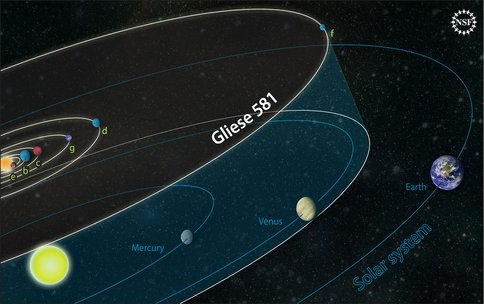2010 Annual Science Report
 University of Hawaii, Manoa
Reporting | SEP 2009 – AUG 2010
University of Hawaii, Manoa
Reporting | SEP 2009 – AUG 2010
Detection of Terrestrial Planets Around M Stars
Project Summary
We have carried out an extensive search for small extrasolar planets around M stars in the solar neighborhood. Our search is focused on planets in the habitable zone. We have been able to detect 4 planets around M stars, among which an Earth-like planet in the habitable zone of star GL 581.
Project Progress
In the quest for potentially habitable planets, the nearest stars are of special importance. These stars have accurate distances and precisely determined stellar parameters, and are the only stars for which follow-up by astrometry and direct imaging is possible. Within the Sun’s immediate neighborhood, M stars constitute the majority (72%) of nearby stars. The proximity, low surface temperatures, and small masses of these stars have made them unique targets for searching for terrestrial and habitable planets. During the past four years, the PI has been actively involved in the detection of extrasolar planets around M stars both in theoretical and observational fronts. As part of PI’s initiative on searching for small planets around M stars, and in collaboration with the Carnegie Institution of Washington and UC Lick Observatory, we have recently discovered 8 new planets among which are i) an Earth-like planet in the habitable zone of the M star Gliese 581 (figure 1), ii) a Saturn-mass planet in the habitable zone of the M dwarf HIP 57050, and iii) a new Uranus-mass planet in a Laplace resonance in the multi-planet system around M star GJ 876. We have also identified 50 other M stars as potential targets for detecting terrestrial/habitable planets.
Figure 1. Artistic rendition of a comparison between orbits of planets around Gliese 581 and the inner solar system. As expected, planets of Gliese 581 are in a packed order in close orbits.
Publications
-
Haghighipour, N., Vogt, S. S., Paul Butler, R., Rivera, E. J., Laughlin, G., Meschiari, S., & Henry, G. W. (2010). THE LICK-CARNEGIE EXOPLANET SURVEY: A SATURN-MASS PLANET IN THE HABITABLE ZONE OF THE NEARBY M4V STAR HIP 57050. The Astrophysical Journal, 715(1), 271–276. doi:10.1088/0004-637x/715/1/271
-
PROJECT INVESTIGATORS:
-
RELATED OBJECTIVES:
Objective 1.2
Indirect and direct astronomical observations of extrasolar habitable planets.



